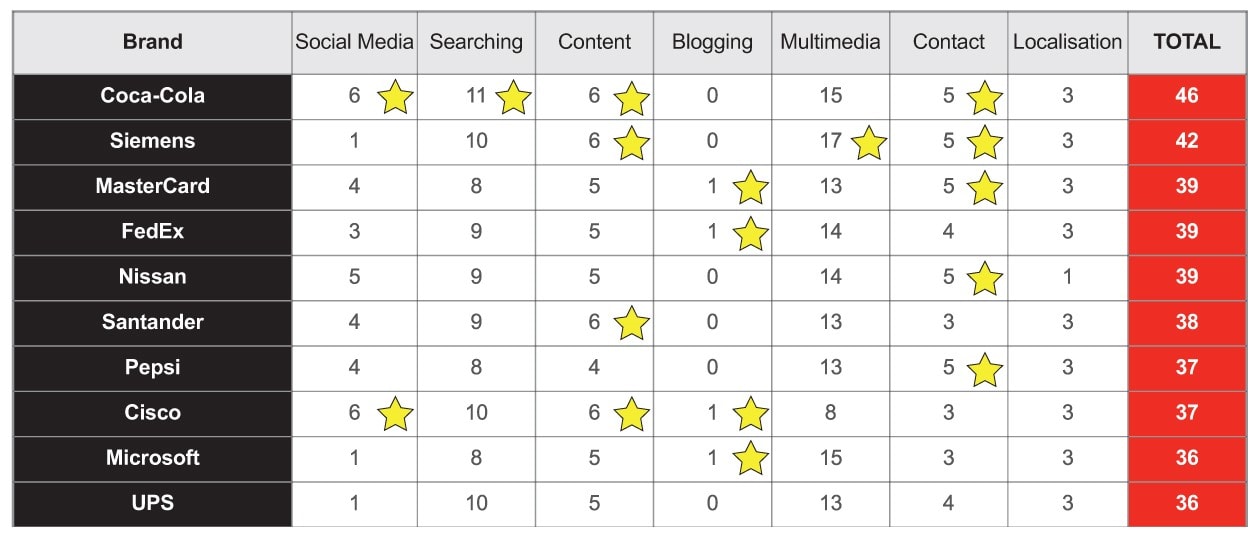A brand’s web presence must reflect the brand honestly and clearly, as it is usually the first point of call for journalists and customers looking for information. But many brands are failing to show themselves in the best light online claims a study from newsroom specialists Mynewsdesk. The study analysed the online newsrooms of the top 100 global brands, to see how accessible and helpful these are. Criteria used included looking at the content provided, multimedia resources, social media links and contact information offered.
One of the most basic areas where brands fail is that over one third (35 per cent) contain out-of-date information. Adam Cranfield, head of marketing at Mynewsdesk explains: “This could be anything: whether executive bios, annual reports, fact sheets or product listings. With these being the 100 biggest brands in the world, it is staggering that they are failing to keep their information up-to-date, but even more so when one considers that many of these are publicly listed companies where reporting of out-of-date information could have a direct, negative impact on their business.”
The table below shows the brands that scored lowest in Mynewsdesk's study:
.jpg)
Areas where brands fall down on their websites:
- 40 per cent fail to provide a basic image library. Images are now an absolutely essential part of any communication.
- Video is no longer a niche format online, it's becoming expected by consumers. Half of the top brands don't feature video content in their newsroom.
- It is particularly disappointing that 45 per cent of brands fail to include contact details on press releases.
- Email is still the favoured way for journalists and bloggers to stay up to date with brand news, yet 70 per cent of brands aren't providing a way to subscribe to email updates. RSS is also popular, and 44 per cent do not offer that.
- While brands like Cisco and Intel publish plenty of "value-add" content relating to their broad sector, they are currently in the minority. Only 22 per cent of the top brands are using their newsroom to share blog posts, opinion pieces or customer-facing info.
Not all news is bad news, however. Some brands, including Coca-Cola, Siemens and Mastercard, are combining a strong content strategy with effective digital newsroom platforms, as you can see from the table below. These brands underline valuable lessons about how to create and distribute great content online.

Good-practice guidelines:
- The most digitally evolved brands are accomplished publishers, with sophisticated social media newsrooms supporting their content strategies. PROs today have to create content for a range of audiences; not just journalists, but also bloggers, influencers and customers.
- Good communicators tell their brand stories in a way that is multimedia, multichannel and realtime.
- An online newsroom must provide the full set of news and content assets in one place. If someone wants to talk about your brand, you want to make it as easy as possible for them to find your news, blogs, images, videos and social media channels.
- It is important to keep updating content. Some brands are streaking ahead in the content race. Cisco is publishing over 80 articles a month, but the average across the top 100 brands is 11 articles a month.
Methodology
Mynewsdesk evaluated the top 100 global brands from the Millward Brown’s 2012 Brandz Top 100 during the last months of 2012. The criteria for scoring each newsroom included accessibility; the content provided; multimedia available; search functions; social media and contact details.
PR Masterclass: The Agency Growth Forum
Our experts will each give you a 20-minute Masterclass on what we've identified as the 11 most important elements in running a modern, profitable and successful PR firm.
Taking place on Wednesday 26th November in London, both virtual and in person tickets are available.
Tickets on sale now!
PR MasterclassIf you enjoyed this article, sign up for free to our twice weekly editorial alert.
We have six email alerts in total - covering ESG, internal comms, PR jobs and events. Enter your email address below to find out more:







